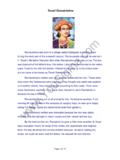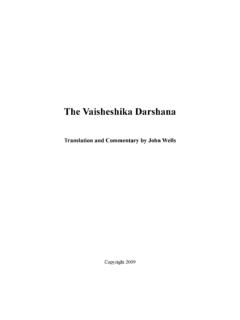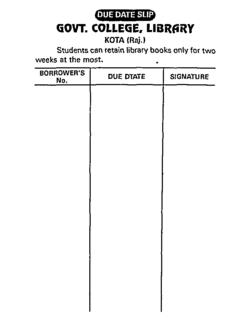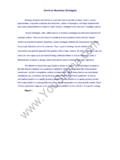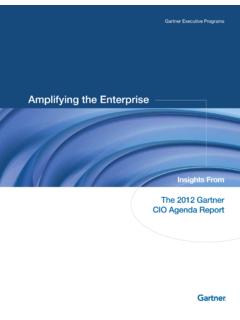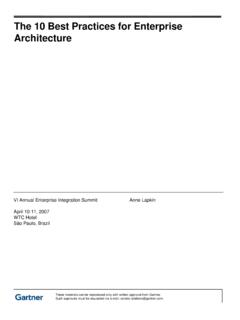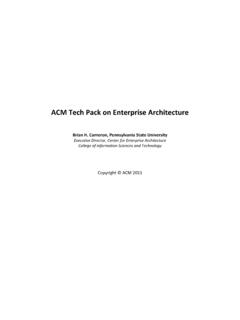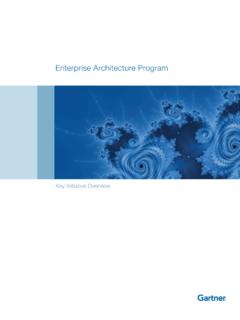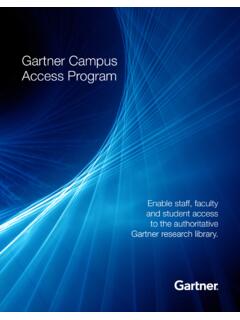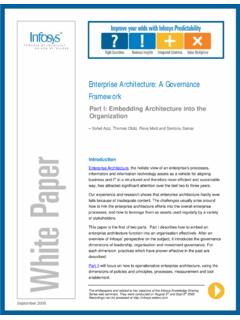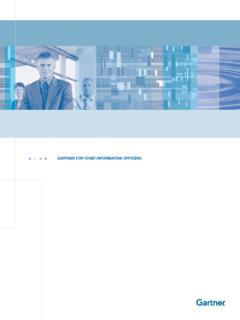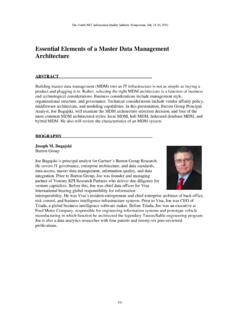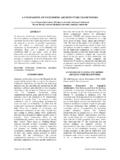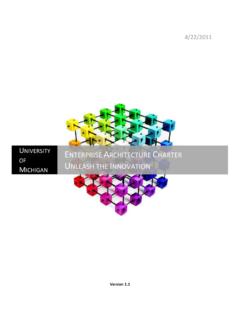Transcription of Enterprise Architecture Methodologies and …
1 Enterprise Architecture Methodologies and Comparisons 1. The Zachman Framework for Enterprise Architectures The first thing we need to understand about the Zachman Framework is that it isn't a framework. The Zachman "Framework" is actually a taxonomy for organizing architectural artifacts (in other words, design documents, specifications, and models) that takes into account both who the artifact targets (for example, business owner and builder) and what particular issue (for example, data and functionality) is being addressed. For Example, from the business owner's perspective, "data" means business entities.
2 This can include information about the entities themselves, such as customers and products, or information about relationships between those entities, such as demographic groups and inventories. If you are talking to a business owner about data, this is the language you should use. From the perspective of the person implementing the database, "data" does not mean business entities, but rows and columns organized into tables and linked together by mathematical joins and projections. If you are talking to a database designer about data, don't talk about customer demographic groups, but talk about third-normal relational tables.
3 2. The Open Group Architecture Framework (TOGAF) TOGAF describes itself as a "framework," but the most important part of TOGAF is the Architecture Development Method, better known as ADM. ADM is a recipe for creating Architecture . A recipe can be categorized as a process. Given that ADM is the most visible part of TOGAF, it can be categorized overall as an architectural process, instead of either an architectural framework (as The Open Group describes TOGAF) or a methodology (as it describes ADM). Viewed as an architectural process, TOGAF complements Zachman categorized as an architectural taxonomy.
4 Zachman tells you how to categorize your artifacts. TOGAF gives you a process for creating them. Page 1 of 9 Enterprise Architecture Methodologies and Comparisons The TOGAF Architecture Development Method (ADM) TOGAF divides an Enterprise Architecture into four categories, as follows: 1. Business Architecture Describes the processes the business uses to meet its goals 2. Application Architecture Describes how specific applications are designed and how they interact with each other 3. Data Architecture Describes how the Enterprise datastores are organized and accessed 4.
5 Technical Architecture Describes the hardware and software infrastructure that supports applications and their interactions 3. Federal Enterprise Architecture (FEA) FEA has both a comprehensive taxonomy, like Zachman, and an architectural process, like TOGAF. FEA can be viewed as either a methodology (taxonomy, FEA process , and FEA reference model) for creating an Enterprise Architecture or the result of applying that process to a particular Enterprise namely, the Government. Page 2 of 9 Enterprise Architecture Methodologies and Comparisons Suppose the Internal Revenue Service (IRS) decides it needs a demographics system to track taxpayer data.
6 They ask around to see if anybody has one they can modify for their purposes. Nobody does. Little do they know that, right next door, the Government Printing Office (GPO) has a perfectly good demographics system that is almost exactly what the IRS needs. They just happen to call it a customer-analytics system. So, the IRS goes out and builds its system from scratch, instead of just modifying the one already built (and paid for) by the GPO. And, in doing so, the IRS will waste considerably more money. This, in a nutshell, is the goal of the five FEA reference models: to give standard terms and definitions for the domains of Enterprise Architecture and, thereby, facilitate collaboration and sharing across the federal government.
7 The five reference models (as in TOGAF categories) are as follows: 1. The Business Reference Model (BRM) gives a business view of the various functions of the federal government. For example, the BRM defines a standard business capability called water resource management that is a subfunction of natural resources that is considered a line-of-business of the broader services for citizens business area. [29] 2. The Components Reference Model (CRM) gives a more IT view of systems that can support business functionality. For example, the CRM defines a customer-analytics system that is a hypothetical interchange between the IRS and the GPO.
8 [30] 3. The Technical Reference Model (TRM) defines the various technologies and standards that can be used in building IT systems. For example, the TRM defines HTTP as a protocol that is a subset of a service transport that is a subset of service access and delivery. [31] Page 3 of 9 Enterprise Architecture Methodologies and Comparisons Page 4 of 9 4. The Data Reference Model (DRM) defines standard ways of describing data. For example, the DRM defines an entity as something that contains attributes and participates in relationships. [32] 5. The Performance Reference Model (PRM) defines standard ways of describing the value delivered by Enterprise architectures.
9 For example, the PRM describes quality as a technology measurement area that is defined as "the extent to which technology satisfies functionality or capability requirements." [33] The FEA Process as in TOGAF-ADM, includes: Step 1: Architectural Analysis Define a simple and concise vision for the segment, and relate it back to the organizational plan. Step 2: Architectural Definition Define the desired architectural state of the segment, document the performance goals, consider design alternatives, and develop an Enterprise Architecture for the segment, including business, data, services, and technology architectures.
10 Step 3: Investment and Funding Strategy Consider how the project will be funded. Step 4: Program-Management Plan and Execute Projects Create a plan for managing and executing the project, including milestones and performance measures that will assess project success. Enterprise Architecture Methodologies and Comparisons 4. gartner Is not a taxonomy (like Zachman), a process (like TOGAF), or a complete methodology (like FEA). Instead, it is a practice. It is the Enterprise - Architecture practice of one of the best known IT research and consulting organizations in the world: gartner You don't bring in gartner because they do or don't use TOGAF.
